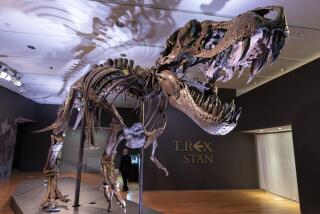Scientists see evidence of iridescent rainbow feathers on a dinosaur
- Share via
A team of Chinese, American and Belgian scientists have unearthed a 161-million-year-old dinosaur fossil showing that the animal may have had vibrant, iridescent plumage like that of peacocks and other birds today.
The fossil of the dazzling dinosaur, described in the journal Nature Communications, sheds fresh light on the evolution of these ancient animals and their relationship to birds.
Caihong juji, the fossil of which was first found by a farmer in northeastern China, was roughly the size of a duck and covered in feathers. It’s a theropod, like Tyrannosaurus rex, but more specifically it’s a member of Paraves – a group of dinosaurs whose members include the lineage that gave rise to birds. Paraves often had feathery plumage, among other bird-like characteristics. (C. juji is a member of Paraves but was not part of the bird lineage.)
C. juji had a strange mix of characteristics that immediately caught the eye of Julia Clarke, a vertebrate paleontologist at the University of Texas at Austin and one of the paper’s senior authors.
The dinosaur fossil had short forelimbs but very long feathers on those limbs. It had a huge fan tail, similar to that of Archaeopteryx, its more famous feathered cousin. It had asymmetrical feathers in part of the tail – which is surprising, because such asymmetrical feathers are used for flying and thus are typically found in the wings. And the skull had ‘lacrimal crests’ that looked like bony eyebrow ridges. Those crests are found on much older dinosaur species, and haven’t been seen on younger species with “true” feathers.
“I immediately saw this combination of features that was really striking and looked really new,” Clarke said. “This was an important animal.”
More surprises lay within the remnants of the feathers themselves. Using scanning electron microscopy, the researchers examined the parts of cells that hold pigment, called the melanosomes. Normally, these pigments would basically look black when viewed up close. But for many brightly colored animals, the colors we see aren’t just based on simply on the pigment contents, but on how those pigments are organized and structured. Different structures can bend light in different ways, giving rise to a variety of colors or effects.
In this case, the melanosomes were shaped into oval pancakes – a shape that’s seen in the shimmering plumage of hummingbirds today.
“When iridescence is created, the organization of the melanosomes matters,” Clarke said. While the shape of the melanosomes is telling, she said, the actual organization of the melanosomes wasn’t clear. “We haven’t yet found it in these fossils.”
The scientists think that C. juji sported iridescent feathers on its head as well as in its wings and tail, probably putting them to use as a type of sexual display, to show off to potential mates.
The fact that these showy feather colors existed at the same time as the prominent eyebrow ridge was surprising, Clarke said. Both are thought to be used for sexual display, but since the ridges typically seemed to disappear in dinosaur species that were akin to C. juji.
“We think it tells us about rates of character evolution,” she explained. “We have a lot of apparently rapid change, a lot of diverse species and combinations of features, and it confirms the importance of sexual selection as a driver of some of the traits around that key time period at the origin of flight in dinosaurs.”
Among the next steps, she added, was to learn more about this feathered creature’s lifestyle. Since it probably wasn’t fully airborne, how exactly did this dinosaur move? Was that tail just for show, or did it somehow help the dinosaur get around? What was its ecology like?
“There’s a whole suite of interesting questions around there that I think are really cool,” she said.
Follow @aminawrite on Twitter for more science news and “like” Los Angeles Times Science & Health on Facebook.
MORE IN SCIENCE
Even without nudging blood pressure up, high-salt diet hobbles the brain
Erosion is revealing surprising amounts of water ice on Mars






